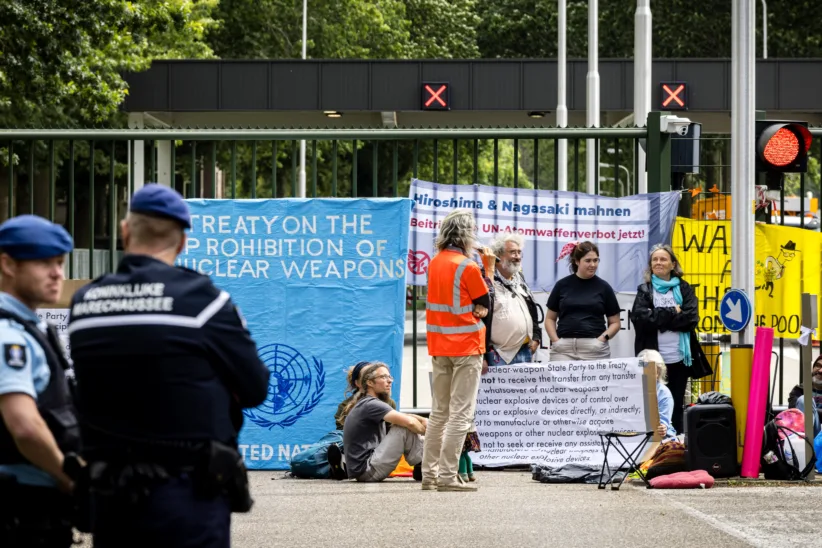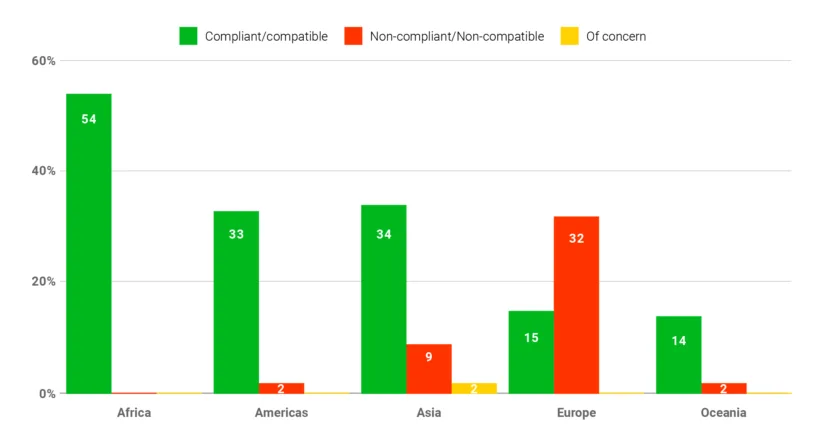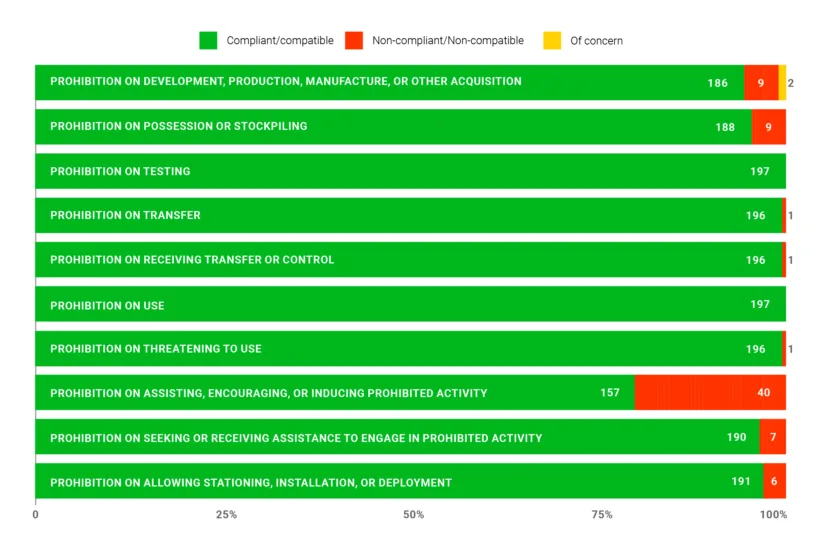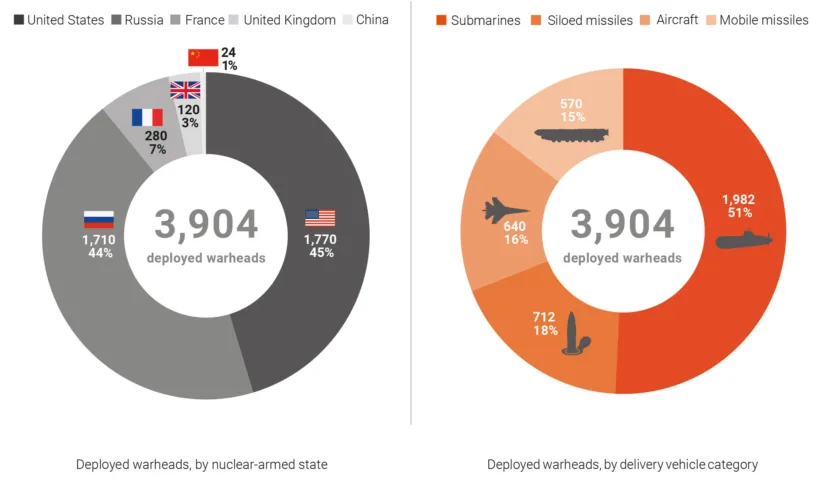“Europe a major obstacle to nuclear disarmament”
One hundred and fifty states—or more than three quarters of all states—already abide by all of the prohibitions of the 2017 United Nations Treaty on the Prohibition of Nuclear Weapons (TPNW), while a sizeable minority of 45 states currently engage in activities that are not compatible with the Treaty. Of those, 32—over 70%—are European states, shows the latest edition of the Nuclear Weapons Ban Monitor, which was launched on 30 July 2024.

“At a time when the risk of the use of nuclear weapons is a profound concern, it is appalling that as many as 32 of the 47 states in Europe do not yet meet the demands of the Treaty that bans these weapons of mass destruction. Europe is a hotbed of policies and practices that aid and abet nuclear armament. We need more public discussion about how this complicit conduct increases risk and makes Europe a major obstacle to nuclear disarmament, says Secretary-General Raymond Johansen of Norwegian People’s Aid (NPA), the organisation that publishes the Nuclear Weapons Ban Monitor, a dedicated report with contributions from leading nuclear experts and disarmament institutions.
The Ban Monitor assesses the conduct of every state—regardless of whether it has joined the TPNW— in relation to the Treaty’s comprehensive prohibitions of developing, producing, testing, stockpiling, transferring, and using or threatening to use nuclear weapons, as well as hosting another state’s nuclear weapons. It also prohibits assisting or encouraging these prohibited activities.
- Read the full report here: Nuclear Weapons Ban Monitor 2023 (flippingbook.com)

The Ban Monitor collaborates with the Nuclear Information Project of the Federation of American Scientists (FAS) to analyse global nuclear forces, and the latest report publishes FAS’ most recent arsenal estimates, updated in July 2024. The nine nuclear-armed states are estimated to have a combined inventory of 12,347 nuclear warheads. At least 9,585 warheads, whose collective explosive yield equates to more than 135,000 Hiroshima bombs, are available for use by the military (the others are awaiting dismantlement in Russia and the United States). It is also estimated that 3,904—or more than 40% of the warheads available for use—at all times are deployed with operational forces, ready for use, meaning that they are uploaded on siloed and mobile missiles and on submarines or co-located with aircraft at bomber bases.
“Instead of reducing the numbers and role of nuclear weapons, the nuclear-armed states are increasing reliance on nuclear weapons, adding enhanced or new types, and in most cases increasing their arsenals,” says Hans M. Kristensen, the Director of the Nuclear Information Project at FAS and a key contributor to the Ban Monitor. “This is happening in a significantly deteriorated security environment that has ended the post-Cold War nuclear order of reduced nuclear arsenals and put the world on a path of increased nuclear risks,” he said.

Research by the Ban Monitor also shows that only two of the ten TPNW prohibitions are not being contravened by any state: the prohibitions on testing and use. “This is alarming, and it speaks volumes about the urgent need to reject and roll back the policies and activities that are conflicting with all of the other prohibitions of the TPNW, because this is conduct that can lead to devastating new testing or use of nuclear weapons,” says NPA Secretary-General Johansen.
States with arrangements of extended nuclear deterrence with nuclear-armed states—the so-called ‘umbrella states’—bear a considerable degree of responsibility for the fact that trillions of dollars are being poured into the continued development and possession of nuclear weapons, and for the consequent nuclear risks that the whole world is forced to endure. All of the world’s 34 umbrella states—the overwhelming majority European—are assisting or encouraging acts prohibited under the TPNW. All umbrella states endorse nuclear-weapons doctrines and policies. Many also participate in nuclear planning and nuclear strike exercises, provide dual-capable aircraft for delivery of nuclear weapons, conventional capabilities in support of nuclear forces, or other logistical and technical support. Some allow companies on their territories to develop, produce, and maintain key components for nuclear weapons, or to provide financial assistance to the nuclear-arms industry. The list of active umbrella states includes Belgium, Germany, Italy, and the Netherlands.
“This litany of assistance to unlawful action stands between the international community and the fulfilment of the United Nations’ long-standing goal of the elimination of nuclear weapons. It is conduct that receives too little attention. The world’s umbrella states should take a good look in the mirror and think where their actions may lead us,” says Johansen.
A minority of 43 states (the nine nuclear-armed states and the 34 umbrella states) currently embrace the security logic of nuclear deterrence. According to Professor Nick Ritchie of the University of York, who also contributes to the Ban Monitor, the view that nuclear deterrence provides security rests on a mistaken assumption that nuclear weapons-related risks can be known and that they can be controlled: “Evidence shows us that these risks are not knowable and not controllable, but subject to chance and luck. Once we accept that luck plays a role in the outcome of nuclear crises, nuclear deterrence as a legitimate and necessary paradigm becomes deeply questionable. What remains is that nuclear weapons are a source of constant insecurity in themselves, to all of us,” says Ritchie.
He adds that since its negotiation and adoption in 2017, the TPNW has embedded itself as the sole multilateral forum where states firmly demonstrate their rejection of nuclear deterrence and their will for nuclear disarmament, and cooperate on forging a path towards the elimination of nuclear weapons. As of the end of July 2024, almost half of all states had become party to or had signed but not yet ratified the TPNW. With 70 states parties and a further 27 signatories, the formal endorsement of only two more states is needed to pass the 50% threshold of support among the 197 states in the world today. Support for the TPNW is generally high in all regions of the world apart from Europe. Europe has by far the highest concentration of states that are opposed to the Treaty, reflecting the region’s many umbrella states. Thus far, only five European states have become party to the TPNW: Austria, Holy See, Ireland, Malta, and San Marino; and a sixth—Liechtenstein—has signed but not yet ratified the Treaty.
- Read the full report here: Nuclear Weapons Ban Monitor 2023 (flippingbook.com)
Figures




